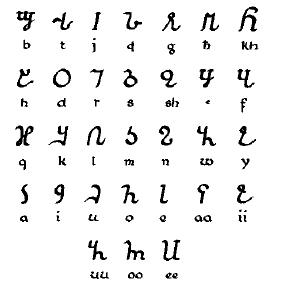Somali language
Somali language is a member of the Afro-Asiatic language family, specifically within the Cushitic branch, making it related to languages such as Oromo and Afar. It is the official language of Somalia and also has official status in the Somaliland region and Djibouti. Somali is spoken by approximately 15 to 20 million people worldwide, with the majority of speakers residing in Somalia, Somaliland, Ethiopia, Kenya, and Djibouti. The language has a rich oral tradition but was not written down until the 20th century, leading to a vibrant culture of poetry, storytelling, and song.
History[edit | edit source]
The Somali language has a long oral history, but it was not until the 1972 government decree that the Latin alphabet was adopted as the official script for the Somali language, replacing previous scripts such as the Arabic-based Osmanya script, the Kaddare script, and the Borama script. This standardization was part of a broader literacy campaign within the country.
Dialects[edit | edit source]
Somali is divided into three main dialect groups: Northern Somali or Somali, which serves as the basis for standard Somali; Benaadir (coastal Somali), spoken in the Mogadishu area; and Maay Maay, primarily spoken in southern Somalia. While these dialects are mutually intelligible to a degree, they exhibit distinct phonological, lexical, and grammatical differences.
Phonology[edit | edit source]
The phonological system of Somali is characterized by its use of tone, with pitch playing a crucial role in distinguishing word meaning. Somali has a set of 21 to 22 consonants and five vowel sounds, which can be short or long, making vowel length phonemically significant.
Grammar[edit | edit source]
Somali grammar is notable for its use of subject-object-verb (SOV) word order, which is relatively uncommon globally. The language employs a system of noun classes with specific article and adjective agreements, and it uses suffixes to indicate tense and aspect in verbs.
Writing System[edit | edit source]
The Somali language uses a modified version of the Latin alphabet, consisting of 26 letters. Unique to Somali, certain letters have diacritic marks to represent specific sounds not found in the English language. The adoption of the Latin script has facilitated the spread of literacy and education in the Somali-speaking regions.
Literature and Media[edit | edit source]
Somali literature, traditionally oral, encompasses a wide range of genres, including poetry, proverbs, and songs. The introduction of the written form of the language has led to the emergence of a burgeoning literature scene, with works of fiction, non-fiction, and scholarly texts being published. Somali media, including newspapers, radio, and television, play a vital role in the dissemination of the language and culture.
Education and Status[edit | edit source]
The Somali language is taught in schools across Somalia, Somaliland, and in parts of Ethiopia, Kenya, and Djibouti where Somali-speaking populations reside. It is also offered in some university programs around the world, promoting the study and preservation of the language and culture.
Challenges and Preservation[edit | edit source]
Despite its official status and widespread use, the Somali language faces challenges, including dialectal fragmentation, the displacement of speakers due to conflict, and the dominance of foreign languages in certain spheres. Efforts to preserve and standardize Somali include the development of language policy, educational programming, and the promotion of Somali literature and media.
Search WikiMD
Ad.Tired of being Overweight? Try W8MD's NYC physician weight loss.
Semaglutide (Ozempic / Wegovy and Tirzepatide (Mounjaro / Zepbound) available. Call 718 946 5500.
Advertise on WikiMD
|
WikiMD's Wellness Encyclopedia |
| Let Food Be Thy Medicine Medicine Thy Food - Hippocrates |
Translate this page: - East Asian
中文,
日本,
한국어,
South Asian
हिन्दी,
தமிழ்,
తెలుగు,
Urdu,
ಕನ್ನಡ,
Southeast Asian
Indonesian,
Vietnamese,
Thai,
မြန်မာဘာသာ,
বাংলা
European
español,
Deutsch,
français,
Greek,
português do Brasil,
polski,
română,
русский,
Nederlands,
norsk,
svenska,
suomi,
Italian
Middle Eastern & African
عربى,
Turkish,
Persian,
Hebrew,
Afrikaans,
isiZulu,
Kiswahili,
Other
Bulgarian,
Hungarian,
Czech,
Swedish,
മലയാളം,
मराठी,
ਪੰਜਾਬੀ,
ગુજરાતી,
Portuguese,
Ukrainian
Medical Disclaimer: WikiMD is not a substitute for professional medical advice. The information on WikiMD is provided as an information resource only, may be incorrect, outdated or misleading, and is not to be used or relied on for any diagnostic or treatment purposes. Please consult your health care provider before making any healthcare decisions or for guidance about a specific medical condition. WikiMD expressly disclaims responsibility, and shall have no liability, for any damages, loss, injury, or liability whatsoever suffered as a result of your reliance on the information contained in this site. By visiting this site you agree to the foregoing terms and conditions, which may from time to time be changed or supplemented by WikiMD. If you do not agree to the foregoing terms and conditions, you should not enter or use this site. See full disclaimer.
Credits:Most images are courtesy of Wikimedia commons, and templates, categories Wikipedia, licensed under CC BY SA or similar.
Contributors: Prab R. Tumpati, MD




